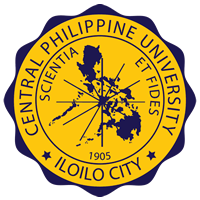By Mikee Natinga Norico

Dr. Aries Roda D. Romallosa (4th from L), Acting Vice President for Research, Development, and Extension, and resource speaker Mr. Brian Golez Gumban (4th from R) are joined by representatives from OVPRDE-aligned units, the Office of Communications, and the Office of Institutional Advancement for a group photo after the successful whole-day activity, “CommuniBrand: Capacity Building on Strategic Communication and Branding.”
Central Philippine University (CPU), through the Office of the Vice President for Research, Development, and Extension (OVPRDE), spearheaded a whole-day activity titled “CommuniBrand: Capacity Building on Strategic Communication and Branding” on September 17, 2025, at the CPUGAD TBI Co-Working Space.
The event brought together representatives from OVPRDE-aligned units, including the University Research Center (URC), Community Engagement and Service-Learning Center (CESLC), Research Ethics Review Board (RERB), and CPUGAD TBI, units with RDE functions, along with representatives from the Office of Communications and the Office of Institutional Advancement.
In her opening message, Dr. Aries Roda D. Romallosa, Acting Vice President for Research, Development, and Extension, emphasized the relevance of the training in today’s knowledge-driven environment. “The impact of research, development, extension, and innovation does not end with producing outputs—it depends on how effectively these outputs are communicated, understood, and valued by diverse stakeholders,” she said. She added that CommuniBrand seeks to articulate CPU’s mission, showcase faculty and student outputs, and establish a recognizable identity that enhances trust, visibility, and credibility.
Mr. Brian Golez Gumban, resource speaker, leads a series of sessions and workshops on strategic communication, branding, and audience engagement, equipping attendees with the skills to strengthen institutional visibility and impact.
Serving as the resource speaker, Mr. Brian Golez Gumban facilitated a series of sessions and workshops designed to enhance communication competencies, strengthen branding skills, align communication with institutional goals, promote effective storytelling, and foster a culture of consistent branding across the University’s Research, Development, and Extension (RDE) initiatives.
The first session, Strategic Communication: Building a Foundation for Impact, highlighted that communication should move beyond simple information sharing and instead focus on influence, engagement, and impact. Participants explored the importance of tailoring messages to different audiences—administrators, faculty, researchers, students, industry partners, government agencies, alumni, and policymakers—to ensure relevance and clarity. According to Gumban, avoiding mixed messages and strengthening connections with stakeholders are critical to advancing CPU’s RDE visibility.
In the accompanying Audience Mapping and Message Framing Workshop, attendees identified key audiences, their expectations, and the most effective communication channels. The workshop emphasized that meaningful communication is achieved through consistent, audience-centered messaging that creates lasting impact.
The second session, Branding for RDE: Crafting a Unified Identity, tackled branding as the overall perception people have of an office and its work. Gumban stressed that strong branding—anchored in clarity, consistency, and credibility—reinforces CPU’s reputation as a leader in research and innovation. He differentiated between brand identity (an office’s story, values, and emotional connection) and visual identity (logos, colors, fonts, and design elements).
During the Brand Identity Canvas Workshop, participants were guided in defining their office’s purpose, identifying core audiences, and crafting key messages and taglines. The activity highlighted the collective role of each office in building a unified institutional brand identity that reflects CPU’s values of knowledge creation, service, collaboration, and sustainability.
The final session, Strengthening Visual Identity and Storytelling, guided participants in developing a brand book to ensure consistency in design, messaging, and identity across platforms and materials. Gumban underscored that while data and results are essential, storytelling—structured around the problem, solution, and outcome—makes RDE initiatives more relatable, memorable, and inspiring.
The CommuniBrand activity forms part of the OVPRDE’s WEAVE Program, which builds the capacities of CPU faculty and staff beginning with internal offices. By equipping units with skills in communication and branding, the program fosters continuity, familiarization, and strategic alignment in research and extension activities.
Overall, the sessions and workshops underscored that strategic communication and strong branding are not optional but essential to amplifying CPU’s institutional presence in national and global RDE landscapes. Through clear messaging, consistent branding, and impactful storytelling, CPU continues to strengthen its role as a leader in research, innovation, and community engagement.

